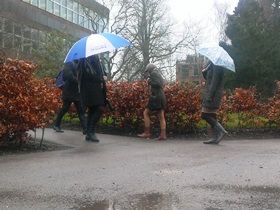Former BBC weather forecaster Bill Giles’ criticism of weather forecasts raises questions about how weather is communicated generally.
Mr Giles has hit out at forecasters for regularly warning the public about the potential consequences of imminent severe weather, arguing they are ‘behaving like nannies’ and could cause the public to become ‘immune’ to the advice.
He added the practice of naming storms had become too frequent, and that forecasters should only advise people about potential dangers for ‘exceptionally severe weather’, which occurs once every few years.
But how much weather information is the right amount for the public? How much do they understand? Could an appreciation of the uncertainty of forecasts actually improve our faith in them?
Research at the University of Reading has shown that not only is the average person able to process more complex weather forecast information, they are likely to make better decisions as a result of the additional information.
Scientists at Reading have therefore begun looking at whether the way weather predictions are presented to the general public can be improved.
While the days of people tuning in to the television to learn whether it will rain tomorrow aren’t over yet, smartphone apps have already begun a revolution in the way we obtain forecasts.
Localised forecast
However, these apps often simplify the data to present a black and white picture – for example, rain or no rain – when the reality is, like the Great British skies, somewhat greyer. The original data from agencies like the Met Office or AccuWeather often clearly portrays this uncertainty, yet many apps present only the most likely outcome.
Mobile phone apps also present the user with a highly localised forecast, often with limited information provided about the level of detail the forecast can accurately predict. (We published research into the issues from mobile phone apps in 2015.)
The Met Office responded to Mr Giles’ comments by saying members of the public are more concerned about the impact of weather on their day-to-day lives than the meteorological processes behind it. Making forecasts that allow people to make well informed decisions based on uncertain forecasts is a really important area of research in which Meteorologists can learn a lot from other fields like psychology and information design, something which our research team at Reading has been exploring.
One of the exciting parts of thinking about how weather forecasts are produced is that technological development has meant that there are an almost limitless number of ways in which forecasts can be produced and tailored to individual end users. The challenge for both the public and private sectors is coming up with innovative ways of displaying weather forecast information that are fun and enjoyable to use, while also being informed by our current understanding of how humans process complex information.
But with this week’s criticism of current forecasts, it seems really important to develop a dialogue between academia, forecast providers and the public about what our weather forecasts will look like in the future.
- Research on how best to present weather information will be presented by Reading scientists at a Royal Meteorological Society public meeting on 20 September 2017 entitled ‘Message impossible? Conveying weather information in the digital age’.
- This is a public meeting and we will shortly be launching a way for members of the public to get involved with the meeting and tell us the new ways they would like to see and use weather forecasts.
